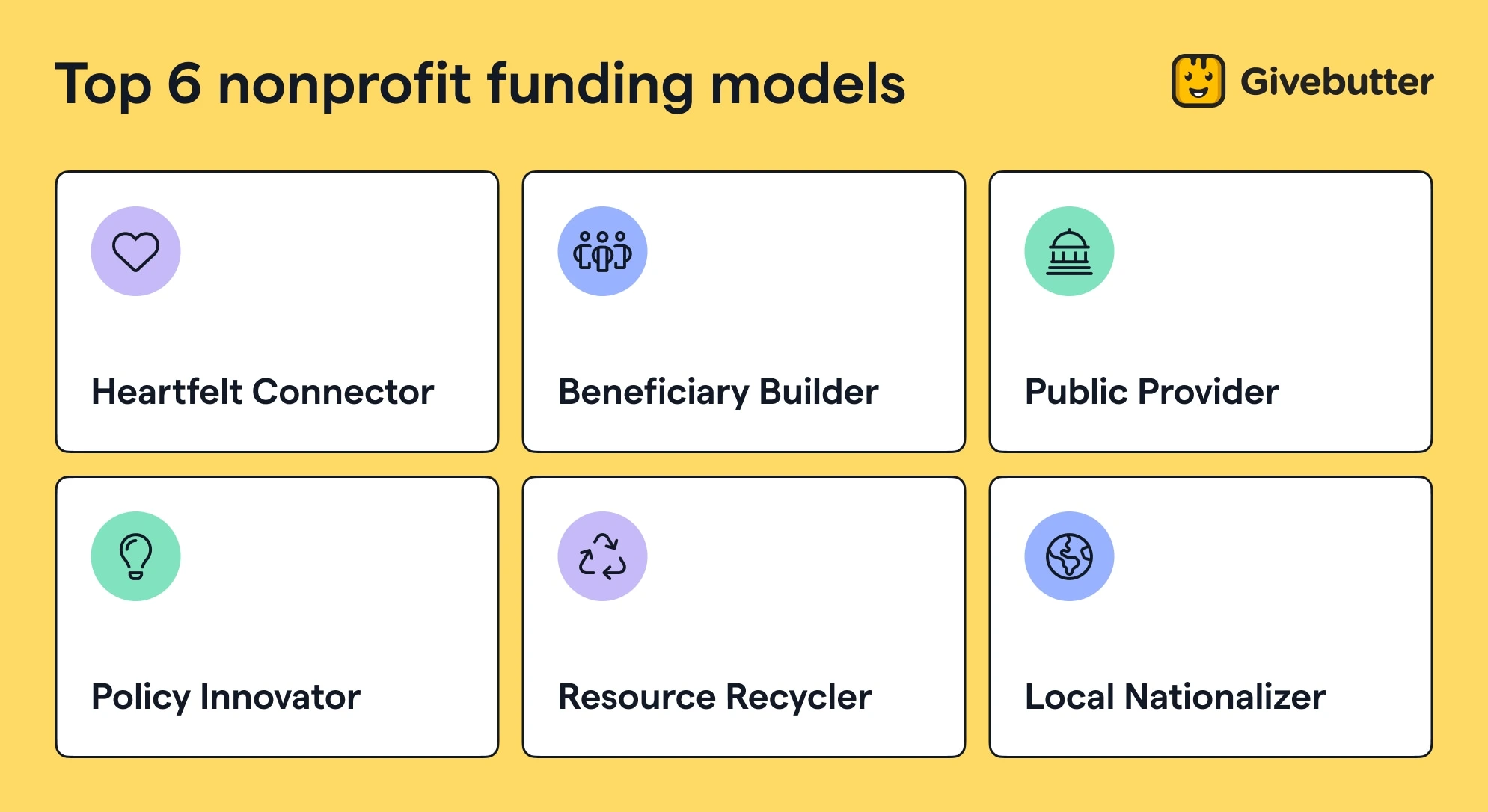Table of contents
Table of contents
Trends come and go, but some nonprofit funding sources stand the test of time. It’s smart to diversify your income to avoid over-reliance—but how do you know what your options are?
In this guide, we’ll explore income streams for nonprofits—from our favorite sources to tips for finding success with whichever path you choose.
Where do nonprofits get funding?
Even if your current strategy focuses on one fundraising approach, there are many different sources of revenue for nonprofits worth exploring.
Here’s an overview of what you need to know about funding sources for nonprofit organizations:
- Individual donors remain the most significant funding source for most nonprofits.
- Competition for grants can be high, but there are ways to stand out.
- Relationship-building is key to nearly every type of funding opportunity
- Selling products and services can be an effective way to raise funds
- Successful fundraising requires strategy—clear goals, strong engagement, and consistent donor stewardship.
Every nonprofit is different, so there’s no one-size-fits-all ratio of funding sources. The best approach is to utilize a number of income sources—and fortunately, there are many options to choose from!
The 10 best nonprofit funding sources at a glance
- Individual donations: Best for raising funds and awareness
- Major gifts: Best for large monetary donations
- Crowdfunding campaigns: Best for raising funds at scale
- Foundation grants: Best for high-profile funding from a reliable source
- Corporate contributions: Best for loyal support from local and national businesses
- Government grants and contracts: Best for significant contributions for specific purposes
- Membership fees and dues: Best for recurring support from your community
- Tax programs: Best for incentivizing further giving
- Bequests: Best for large donations from loyal supporters
- Selling goods and services: Best for revenue generation at scale
1. Individual donations 👤
⭐ Best for: Raising funds and awareness
One of the most common ways to fund a nonprofit is through individual donations. These contributions—both small and large—come from supporters who give throughout the year via major gifts, grassroots campaigns, fundraising events, and more. These contributions can be made as a one-time gift or on a recurring basis.
Types of individual donations include:
- In-person donations
- Online donations
- Text donations
- Recurring donations
- Planned gifts
- Matching gifts
- Pledges
Individual donations made up 67% of all giving in 2023, making it one of the most cost-effective ways to bring in funds and build connections. However, it also requires consistent donor cultivation and can be impacted by economic fluctuations, like inflation.
✅ Pros:
- Simple and sustainable
- Easy to implement, especially with the right software
- Opportunity to deliver engaging donor experiences
👀 Cons:
- Attracting and retaining donors can be difficult
- Donation amounts are typically smaller than other funding sources
- Complicated donation forms can deter giving
With a fundraising platform like Givebutter, it’s easy to collect individual donations through online forms, text-to-donate, and peer-to-peer fundraising campaigns. Customize donation forms with recurring giving options and offer convenient payment methods, including Cash App Pay alongside cards, ACH, Venmo, and more.
.webp)
Create your free donation form today
2. Major gifts 🎁
⭐ Best for: Large monetary donations
Major gifts can make a significant impact for your nonprofit—valuable for both early-stage and established organizations. Once you’ve won over a major donor, they often continue to contribute—making it well worth investing time in these relationships.
What constitutes a major gift varies by organization. For smaller nonprofits, the threshold might be $1K. For larger, more established nonprofits, the amount could be $50K or more.
To get started, review your donor database for signals that someone may be ready to increase their giving—or use our DonorSearch wealth screening integration to help identify prospects.
✅ Pros:
- High-impact monetary donations
- Loyal major donors often give regularly
- Helpful when running capital campaigns
👀 Cons:
- Requires a large investment in relationship building
- Major donors require VIP-level donor stewardship
- Your organization needs a compelling mission, vision, and story
From identifying potential major donors to nurturing relationships, major gift solicitation takes a lot of care and attention. Givebutter streamlines your stewardship process with a full spread of email marketing and donor management tools, including soft credits to help you keep track of major gifts and any board members or contacts who influenced them.
3. Crowdfunding campaigns 📣
⭐ Best for: Raising funds at scale
Crowdfunding is a leading way for people to raise money, and it’s not just for individual causes—nonprofits can enjoy a slice of the action too. A successful crowdfunding campaign doesn’t just bring in financial support; it also draws more attention to your cause, enabling you to grow further.
These campaigns work well because donors can contribute any amount and feel like they’re making a difference. With enough of these small donations, you can achieve your fundraising goal—and celebrate your win together.
✅ Pros:
- Attracts donations from a wide range of supporters
- Easier for your campaign to go viral or reach a broader audience
- Can be less time-intensive than other sources
👀 Cons:
- Requires an initial audience to get the campaign going
- May raise less if your supporter base is small
- Needs regular updates and encouragement to keep momentum
💡 Pro tip: Givebutter’s Meta fundraising integration adds an eye-catching donate button and progress bar to your Facebook posts and Instagram Stories when you share your Givebutter campaign link, boosting conversions and impact.
4. Foundation grants 📋
⭐ Best for: High-profile funding from a reliable source
Foundation grants offer financial support from private foundations and grant-making organizations for specific projects or initiatives. In 2023, foundations made up 19% of all nonprofit giving, making them a close second to individual donations. These foundations come in a range of forms, including private foundations, charities, and support organizations.
Finding the right grants to apply for can be challenging, so try our list of grants for nonprofits first. Once you find potential funders, focus on building a relationship with your contact and follow every application instruction to the letter.
Applying for grants can be highly competitive and time-consuming. Some estimates suggest only 1 in 10 grant applications is successful—and may take 15-20 hours to complete.
To win this kind of funding, you must demonstrate not only why your organization needs the support, but why this particular foundation is the best fit to provide it.
✅ Pros:
- A valuable source of significant funding
- Opportunity to build a long-term partnership with funders
- May include in-kind support or increased awareness
👀 Cons:
- Grant funding is highly competitive
- Following all application requirements can be challenging
- Grant proposal writing skills often take time to learn
5. Corporate contributions 🏢
⭐ Best for: Loyal support from local and national businesses
Corporate philanthropy is a partnership with businesses that can provide nonprofits with significant financial support. However, corporations may have specific focus areas, limiting opportunities available to many organizations.
Corporate contributions are often a win for both parties: Your organization receives vital funding or in-kind support (like volunteers or auction prizes), while the company advances its corporate social responsibility (CSR) goals.
Like foundation grants, these contributions from corporations are in high demand and can be competitive. But asking for donations from companies in your local area may offer more success.
✅ Pros:
- Easy way to attract donations and support from local companies
- Beneficial for both you and the company, so it’s an easier sell
- Can be a source of significant funding for projects or events
👀 Cons:
- Requires strong relationships with potential partners
- May be limited opportunities in areas with fewer businesses
- National or international companies can be harder to reach
With Givebutter, you can manage corporate sponsorships and matching programs with company contacts that keep individuals and gifts associated with a particular business in one easy profile.
6. Government grants and contracts ⚖️
⭐ Best for: Significant contributions for specific purposes
Government grants and contracts provide funding from local, state, or federal government agencies for projects that align with public policy objectives.
These opportunities often come with more “red tape” than other funding sources, including strict eligibility rules, complex applications, and detailed reporting requirements.
These grants are also highly competitive. Some estimates suggest success rates for securing a government grant can be as low as 15%, depending on the agency and program. But if you can get your foot in the door, they can be a worthwhile investment of your time and energy.
✅ Pros:
- Can be a reliable source of funding once the contract has been agreed
- Opportunity to raise your profile
- Useful to have the support of an official agency for your work
👀 Cons:
- Extremely competitive
- Applications and reporting may be prohibitively difficult
- Opportunities may shift quickly based on government priorities
7. Membership fees and dues 🤝
⭐ Best for: Recurring support from your community
Popular with many grassroots organizations, this nonprofit funding structure generates revenue through membership dues or fees for specific services, programs, or benefits.
Membership fees can help generate income for community groups and clubs. You can tailor the pricing and benefits depending on your needs and goals, and even create different tiers to encourage higher contributions.
While this model can bring in predictable revenue, long-term success depends on solid member engagement. You’ll need to invest heavily in developing your community and benefits to attract and retain members.
✅ Pros:
- Easy way to raise money from your already-supportive community
- Simple and sustainable way to generate recurring revenue
- Ability to tailor membership benefits to match your supporters’ preferences
👀 Cons:
- Requires ongoing effort to maintain membership numbers and loyalty
- Only brings in a significant sum if you have a large member base
- May require software to manage memberships effectively
8. Tax programs 💸
⭐ Best for: Incentivizing further giving
Tax programs allow organizations to offer tax-deductible contributions or tax credits, which can incentivize sizable contributions. For example, in the US, donors who give to a 501(c)3 charity can claim a deduction on their federal taxes.
And thanks to a recent policy change, nearly all U.S. taxpayers—regardless of whether they itemize—can now deduct a portion of their charitable giving. This update expands the pool of donors who benefit from tax incentives, making it an especially good time to invest in small-dollar fundraising strategies.
These programs often require compliance with complex regulations and may be impacted by law changes—so you’ll need to stay informed. Donors may also need to submit documentation or forms, so remind them to keep donation records.
✅ Pros:
- Encourages donors to make contributions they might not have considered
- Can motivate larger gifts, especially around tax season
- Source of additional support your nonprofit organization
👀 Cons:
- Can be confusing for donors and difficult to promote
- Requires additional admin for compliance purposes
- Donors must keep donation records for their taxes, making it a less attractive option
9. Bequests 🏠
⭐ Best for: Large donations from loyal supporters
Bequests are gifts received through wills, trusts, or estate plans. You might also hear this referred to as planned giving or legacy gifts.
While bequests can offer long-term support, they can involve tax, legal, and administrative complexities. It’s also difficult to promote this type of funding due to its sensitive nature.
✅ Pros:
- Can often bring in significant donations for your nonprofit
- Helps support your initiatives long term
- Recognition of the strong relationship you’ve built with dedicated supporters
👀 Cons:
- Amount and timing of legacy gifts is unknown, making them an unreliable funding source
- Involves additional legal and tax compliance requirements
- Requires a long-term commitment to donor engagement and relationship building
Donor-Advised Funds are a growing avenue for planned giving and major gifts, and Givebutter now makes it easier to accept DAF donations and track them properly.
10. Selling goods and services 👕
⭐ Best for: Revenue generation at scale
Selling goods or services is a great opportunity to raise funds for your cause and engage supporters in a new way—especially the product directly ties back to your mission.
Examples of popular products and services to offer include:
- T-shirts, hats, tote bags, and other apparel
- Pens and stationery items
- Autographed photos or memorabilia
- Courses and workshops
- Ebooks and digital planners
Revenue from products or fees from services can be a helpful addition to your usual funding sources, offering a more stable source of income that doesn’t rely solely on donor solicitation. Digital or print-on-demand products allow you to scale sales significantly—even with a small team.
✅ Pros:
- Fun way for supporters to get involved with your cause
- Opportunity to showcase creativity, entrepreneurial skills, and talent
- Scalable source of earned income that doesn’t directly depend on donor cultivation
👀 Cons:
- Producing good or services requires extra time and money
- Unsold merchandise can create financial challenges
- Requires a different set of skills and knowledge of retail compliance
What are nonprofit funding models?
A funding model is a structured approach to achieving financial stability and long-term sustainability for your nonprofit. The best funding model for your organization depends on your mission and programs.
Funding models can be classified by three main characteristics:
- Funding type: The entity providing the funds (government, individual, corporation, etc.)
- Funder's motivation: The incentives of the donor (altruism, tax breaks, etc.)
- Funding decision maker: The person who ultimately determines whether funding is given or not (foundation board, individual donor, etc.)
Top 6 nonprofit funding models according to type
In order to bring in the most funds possible, it’s crucial to choose a funding model that aligns with your budget, resources, and overall mission.
Nonprofit expert Linda Handley outlines six funding models for nonprofits to consider, based on funder motivations and the unique needs and strengths of different types of organizations.

1. Heartfelt Connector 💛
🔎 Quick overview: Heartfelt Connectors build strong connections between like-minded volunteers and donors through special fundraising events.
👥 Who it’s for: Organizations like Make-A-Wish—which hosts multiple fundraising events each year—that bring together people across income levels who share empathy for the cause.
2. Beneficiary Builder 🏩
🔎 Quick overview: In this model, the organization provides services to individuals, receives payment for those services, and then later encourages those individuals to make additional donations.
👥 Who it’s for: Nonprofits (particularly universities or hospitals like Cleveland Clinic) that establish long-term relationships with donors who are former beneficiaries of their programs.
3. Public Provider 🏛
🔎 Quick overview: The government often allocates funding for specific initiatives to be outsourced to nonprofits.
👥 Who it’s for: Nonprofits like the Success for All Foundation that partner with government agencies to provide essential programs such as housing, education, and human services.
4. Policy Innovator 💡
🔎 Quick overview: These organizations develop innovative approaches to address social issues that aren't compatible with traditional government programs. These organizations receive funding if their methods prove to be more cost-effective or provide more impactful results than existing government programs.
👥 Who it’s for: Nonprofits that have an optimal solution to unmet social needs—and can persuade government funders to support it. For example, Youth Villages sources government funding to help emotionally troubled children and their families live successfully.
5. Resource Recycler ♻️
🔎 The spread: These organizations collect then distribute in-kind donations to recipients in need. While they still fundraise to cover operating costs, the Resource Recycler method allows them to make a difference without incurring the cost of producing or purchasing these resources.
👥 Who it’s for: Nonprofit like Americares Foundation that accept non-monetary donations—such as supplies—from individuals and corporations, then deliver them directly to communities in need.
6. Local Nationalizer 🌎
🔎 Quick overview: The Local Nationalizer model centers on creating an extensive network of locally-based operations that receive funding through individuals, companies, and special events in their own communities.
👥 Who it’s for: Organizations that have several locally-supported branches across the nation that each address the needs of their specific community, like Big Brother Big Sisters of America.
How to get funding for a nonprofit organization in 5 simple steps
Don't get weighed down by the bureaucracy and red tape sometimes involved in the hunt for funds. Instead, follow these five simple steps for a more streamlined approach to your fundraising efforts.
Step 1: Define your goals, mission, and story ✍️
When beginning the search for nonprofit funding, it’s important to determine your short-term and long-term goals—often established through a strategic planning process.
With your mission in mind, answer these questions:
- What will you do with the money you raise?
- How will it further your organization's mission and goals?
- Are your goals SMART (Specific, Measurable, Achievable, Relevant, and Time-Bound)?
Step 2: Create your fundraising team 🏆
Fundraising involves many moving parts. To keep things running smoothly, assemble a team of staff, board members, or volunteers who can take on key roles, such as:
- Fundraising promoter and marketer
- Event organizer
- Volunteer coordinator
- Grant writer
- Finance manager
Depending on the time of year or the projects you have planned, you may need to extend your organizational capacity. Build a strong core team, and consider bringing in consultants or freelancers as needed.
Step 3: Build a prospect list 💪
With your goals and team in place, it will be much easier to carry out your plan. The next step is to research your options within the specific funding sources or model you’ve chosen.
If you’re focusing on individual giving, a prospect list can help you identify who to reach out to first. When building a donor list, consider prospective donors based on:
- Geographic location
- Interests related to your cause
- Demographics
- Education level
- Philanthropic history
- Affiliations
- Ability to give (or wealth capacity)
Make list-building easier with online wealth screening tools like DonorSearch, which can help you understand supporters’ giving capacity.
Step 4: Create a campaign plan 📋
Begin your campaign plan by outlining how you'll raise money. Your fundraising campaign plan should address the following:
- Marketing: How you'll promote your campaign and how people will hear about your fundraising events
- Incentives: How you’ll encourage recurring donations and larger gifts
- Budget: What resources you have to allocate toward your fundraising efforts
Within your annual fundraising plan, be sure to diversify campaigns as much as possible. Avoid putting all your time, energy, and budget into just one or two areas. Instead, test different nonprofit marketing approaches to find what works—and make sure you’re not relying too heavily on one tactic.
Step 5: Show gratitude 🙌
However you raise funds, you always need to build thank-yous into your workplan.
For an individual giving model, showing gratitude can look like:
- Sending a thank-you note and donation receipt promptly after receiving a contribution
- Posting individual and group thank-yous on social media
- Highlighting donor stories in your newsletter
Nonprofit funding made easy with Givebutter
Whether you're just getting started or running a well-established organization, it’s smart to revisit your nonprofit funding strategy. What worked in the past may no longer be effective—and with new technology, there are now even more ways to engage donors.
With Givebutter, you can manage your donor database, launch tailored fundraising pages, and create memorable donor experiences. Our all-in-one fundraising platform makes it easy to run campaigns that attract, engage, and retain those all-important individual donors.
Sign up for free today and see how Givebutter can help you streamline your fundraising, raise more, and save on the tools you need for successful nonprofit funding.
FAQs about nonprofit funding sources
What is the largest source of funding for most nonprofits?
The largest funding source for nonprofits is typically individual donations. Research shows that in 2023, individuals donated more than $103.3B to charitable organizations.
How can small nonprofits compete for foundation grants?
Foundation grants can be competitive, but one of the best ways for small nonprofits to stand out is by building strong relationships with potential funders and clearly demonstrating how their mission aligns with the funding organization’s goals. Our guide on grant proposal writing can help you refine your application skills.
What percentage of nonprofit funding should come from grants?
The ideal percentage of funding from grants depends on your organization. Some nonprofits receive the majority of their funds from corporate or government grants—especially in sectors like education, healthcare, or economic growth. For other organizations, grants represent a smaller percentage of total funding and they rely more heavily on individual donations.
How long does it take to establish a sustainable funding mix?
It can take anywhere from a few months to a few years to build a sustainable funding mix. Revisit your fundraising strategy regularly, test new approaches, and continue building relationships with major donors, grant givers, and individual supporters.
.svg)






%20(1).png)



.svg)











.webp)



